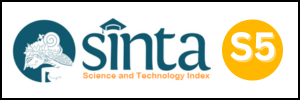Strategi Public Relations dalam Kampanye BatasiGGL Terhadap Brand Reputation PT Nutrifood
DOI:
https://doi.org/10.53682/edutik.v5i3.11771Keywords:
Public Relations, Strategi Komunikasi, Brand ReputationAbstract
ABSTRAK< strong>< em>< p>
Fenomena prevalensi penyakit tidak menular di Indonesia masih menjadi kekhawatiran dalam isu kesehatan Sebagai perusahaan makanan dan minuman yang berfokus pada kesehatan Nutrifood memiliki misi untuk menginspirasi masyarakat agar hidup lebih sehat salah satu inisiasinya adalah kampanye BatasiGGL atau pembatasan gula garam dan lemak Kampanye ini menjadi fokus dalam penelitian ini Strategi yang telah dijalankan selama lebih dari satu dekade turut berkontribusi dalam membentuk citra publik Nutrifood Penelitian ini menggunakan pendekatan kualitatif dan analisis strategi public relations Nutrifood dilakukan dengan menggunakan teori P E N C I L S yang dikemukakan oleh Kriyantono dengan indikator publications event news community involvement identity image dan social responsibility Hasil dari penelitian ini menunjukkan bahwa strategi public relations yang diterapkan oleh Nutrifood sejalan dengan teori P E N C I L S Selama lebih dari satu dekade strategi tersebut berpotensi meningkatkan kesadaran konsumen dan jurnalis serta memberikan kontribusi positif terhadap pembentukan citra dan reputasi Nutrifood < em>< p>
ABSTRACT < strong>< p>
< strong>The prevalence of non communicable diseases in Indonesia remains a significant concern in public health As a health oriented food and beverage company Nutrifood has a mission to inspire people to live healthier lives one of which is through the BatasiGGL campaign promoting the reduction of sugar salt and fat consumption This campaign is the main focus of this study The strategies implemented over more than a decade have contributed to shaping Nutrifood s public image This research adopts a qualitative approach and the analysis of Nutrifood s public relations strategy is based on the P E N C I L S theory by Kriyantono which includes indicators such as publications events news community involvement identity image and social responsibility The findings of this study indicate that Nutrifood s public relations strategy aligns with the P E N C I L S framework Over more than a decade this strategy has shown potential in raising awareness among consumers and journalists while contributing positively to the development of Nutrifood s brand image and reputation < em>< p>
References
Adnanputra A S 2005 Manajemen Public Relations dan Media Komunikasi Jakarta: PT Network Bhakti Persada
Anggraeni T 2023 Proses Community Development PT PLN Indonesia Power Mrica Power Generation Unit PGU Sebagai Bagian Dari Program CSR Doctoral dissertation Sekolah Tinggi Ilmu Komunikasi Yogyakarta
Bernays E L 2013 Public relations University of Oklahoma Press
Fariastuti I Pasaribu M 2020 Kampanye Public Relations Medialawancovid19 Di Media Massa Jurnal Pustaka Komunikasi 3 2 212 220
Jefkins F Yadin D 2003 Public Relations edisi kelima Jakarta: PT Gelora Aksara Pratama
Kriyantono R 2021 Baest practice humas public relations bisnis dan pemerintah: Manajemen humas teknik produksi media publisitas dan public relations writing Prenada Media
Safarudin R Zulfamanna Z Kustati M Sepriyanti N 2023 Penelitian kualitatif Innovative: Journal Of Social Science Research 3 2 9680 9694
Soeryohadi A Adiwijaya M Subagio H Herjanto H 2021 The Effect of Brand Reputation Brand Relationship Quality and Switching Cost to Brand Loyalty Doctoral dissertation Petra Christian University
We Are Social 2024 Digital 2024 October Global Statshot Report
Wilcox D L Cameron G T Reber B H 2015 Public relations: Strategies and tactics Pearson
Yuliani W 2018 Metode penelitian deskriptif kualitatif dalam perspektif bimbingan dan konseling QUANTA: Jurnal Kajian Bimbingan Dan Konseling Dalam Pendidikan 2 2 83 91


